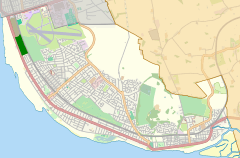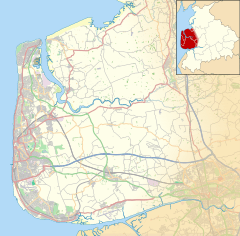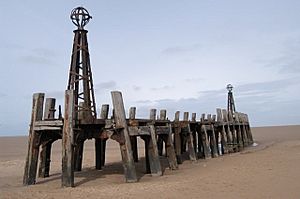St Anne's Pier facts for kids

View of St Anne's Pier
|
|
| Type | Victorian Pleasure Pier |
|---|---|
| Locale | St Anne's-on-the-Sea, Lancashire |
| Design | A. Dowson (1880–1885) Garlick and Sykes (1901–1904) |
| Total length | 600 feet (180 m) |
| Width | 34 feet (10 m) |
| Opening date | 15 June 1885 |
| Coordinates | 53°44′59″N 3°02′06″W / 53.7496°N 3.0351°W |
St Anne's Pier is a fun pier built during the Victorian era. You can find it in the English seaside town of St Anne's-on-the-Sea, which is in Lancashire. The pier sits near where the River Ribble meets the sea.
A. Dowson designed the pier, and it was finished in 1885. It was one of the first big buildings in St Anne's, which was a new town planned in the 1800s. At first, the pier was a calm place for visitors to walk and enjoy the view. Later, more exciting attractions were added. Over time, changes to the river channels, made to help ships reach Preston Dock, left the pier on dry land. This meant that the pier could no longer offer boat trips to Blackpool and Liverpool.
A new entrance building, styled like an old Tudor house, was added in 1899. In the early 1900s, more parts were built, including a beautiful Moorish-style pavilion in 1904 and the Floral Hall in 1910. Sadly, the Moorish Pavilion was destroyed by fire in 1974. The Floral Hall also burned down in 1982. The pier was originally 914 feet (279 m) long, but after the fires, the end part was removed. Now, it is 600 feet (180 m) long. This historic pier is a Grade II listed building, which means it's an important building protected by English Heritage.
Contents
Why St Anne's Pier Was Built
St Anne's-on-the-Sea is a planned seaside town on the Fylde coast. It's located where the River Ribble flows into the sea in Lancashire. This town was developed in the 1800s by a company called the St Anne's Land & Building Company. They started in 1874 and rented land for the new town from a local family.
By the late 1800s, pleasure piers were very popular at English seaside resorts. Nearby, there were already two piers in Blackpool, one in Southport, and another in Lytham. The original plans for St Anne's likely included a pier from the very beginning. A special company, the St Anne's-on-the-Sea Pier and Improvements Company, was set up in 1877. The people in charge believed that a pier in St Anne's would be a great spot for fishing and boating. They thought it would be even better than the places nearby.
Building the Pier
There was a small delay in starting the pier because of money problems. Engineers checked the building site in 1879, and construction finally began in 1880. A. Dowson was the architect who designed it.
The pier is made from strong cast iron columns and criss-cross girders. It has a wooden deck and fancy iron decorations. The columns were sunk very deep, about 50 feet (15 m) into the ground. The first pier was 914 feet (279 m) long and 19 feet (5.8 m) wide. It even had a glass and iron kiosk for a band to play music. Building the pier cost £18,000 and took more than five years.
The pier officially opened on 15 June 1885. Frederick Stanley opened it in a special ceremony. Many important local people, schoolchildren, a band, and members of the Order of Mechanics were there. During the opening, a lifeboat named Laura Janet was launched. Sadly, its crew was lost the next year in a tragic event involving lifeboats from Southport and St Anne's.
Changes and Extensions
In 1891, a wooden landing jetty at the end of the pier was made longer. This was done by Garlick and Sykes, an engineering and architecture company. The new part was made of iron, was three stories high, and measured 120 feet (37 m) long by 90 feet (27 m) wide. After this addition, the pier became 945 feet (288 m) long. This jetty was used for steamer services, bringing people from Blackpool and Liverpool.
However, a law passed in 1883 led to the river channels being dug deeper. This was done to make it easier for ships to reach Preston Dock. These changes meant that the pier eventually ended up on dry land, far from the water. This stopped the popular steamer boat trips from the resort.
A new entrance building was built in 1899. It was designed by J. D. Harker and looked like an old Mock Tudor house, with red bricks and fake timber framing. In 1901, work began to make the pier even bigger and add a Moorish-style pavilion. This pavilion could seat 920 people and was 84 feet (26 m) by 56 feet (17 m). The pier's width was also increased to 34 feet (10 m). Garlick and Sykes also did this work, and the new parts opened on 2 April 1904.
In 1910, more additions were made, including the Floral Hall. This hall was next to the Moorish Pavilion at the end of the pier. It was a winter garden and concert hall that could seat 850 people. Arnold England designed it, and it was built with steel and glass.
Fun Things to Do at the Pier
In the late 1800s and early 1900s, the people who developed St Anne's wanted to attract a more fancy type of visitor than the working-class people who went to Blackpool. The pier was first meant to be a quiet place for visitors to walk. At the very beginning, the only other things to do were listen to a band at a kiosk and buy sweets.
The pier's Floral Hall hosted concerts and music hall shows. The first orchestra to play there was Miss Kate Erl and Her Ladies Orchestra. Many famous artists performed on the pier, including Gracie Fields, Leslie Henson, Russ Conway, and George Formby.
In 1954, an amusement arcade was added to the pier. Today, this arcade takes up three-quarters of the pier's length. Later in that decade, a restaurant was added, and the wooden deck was replaced. By the 1970s, the pier offered even more fun, like crazy golf, a small zoo, and live theatre shows.
Fires and Recent History
In 1962, a company from London bought the St Anne's Land & Building Company, which included the pier. The new owners made some changes, adding an aviary (for birds) and a reptile house. The Floral Hall was also updated and became a beer garden with a Tyrolean style.
On 7 June 1974, a special concert was held for the town's 100th birthday. The famous violinist Yehudi Menuhin performed, and Anne, Princess Royal attended. Sadly, on the night of 20 July, the Moorish Pavilion, which was then called the Sultan's Palace, was destroyed in a fire.
On 6 December 1976, the Webb family bought the pier for £30,000. They planned to fix the fire damage. However, the Floral Hall, which was next to the Moorish Pavilion, was also destroyed by fire on 23 July 1982. Because the pavilions were too damaged to fix, the end part of the pier facing the sea was taken down. People protested against this, and the local council decided that the last 150 feet (46 m) should stay. This was to keep the pier's special look. So, the remains of the old landing jetty are still there.
Most of the pier today is enclosed, meaning it's covered. It ends with an open part of the deck that leads to two hexagonal platforms with small shelters. The part of the pier that is still standing is 600 feet (180 m) long. Today, the pier has an amusement arcade, cafés, and shops. The very end of the pier, facing the sea, is usually closed to visitors.
English Heritage officially named St Anne's Pier a Grade II listed building on 21 September 1973. This means it's a historically important building. It's part of a group of structures on the promenade, including a bandstand, a monument for lifeboats, a pavilion, and two shelters. Experts have said that the pier's Moorish Pavilion and Floral Hall were "two of the best" pier pavilions in terms of their design. The pier is also well-known for its beautiful iron work.




